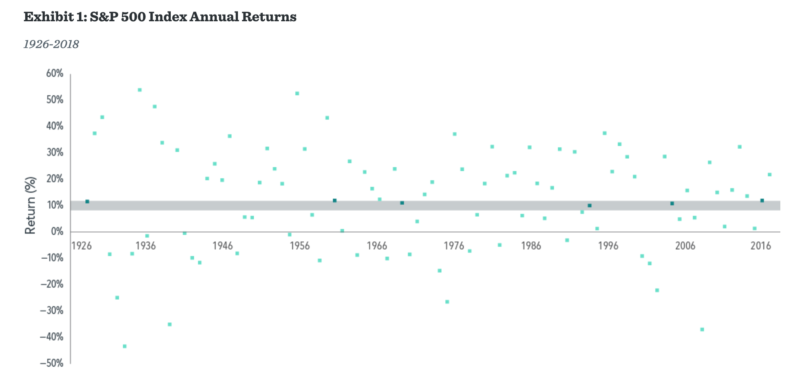
It’s hard to overstate the importance of having a long-term perspective when thinking about investing. This new article from DIMENSIONAL FUND ADVISORS provides a useful illustration.
Historically, the global equity markets have delivered an average annual return of around 10%. The problem, though, for short-term investors, is that in any one year, returns are very unlikely to be 10% or even with a percentage point. In some years, returns will be hugely higher, in some hugely lower.
Far better, then, than focusing on average returns is to think in terms of the range of likely outcomes. Like a good sports coach, don’t get deflated by the downs or carried away by the ups. Historically, stock markets have tended to reward patient investors, and there’s no reason to believe that they will no longer do so in the future.
Global equity markets have delivered an average annual return of around 10% since 1970. But short-term results may vary, and in any given period stock returns can be positive, negative, or flat. When setting expectations, it’s helpful to see the range of outcomes experienced by investors historically. For example, how often have the stock market’s annual returns actually aligned with its long-term average?
Exhibit 1 shows calendar year returns for the S&P 500 Index since 1926. Over this period, the average annual return of the S&P 500 has been 10.0%. The shaded band marks the historical average of 10%, plus or minus 2 percentage points. The S&P 500 Index had a return within this range in only six of the past 93 calendar years. In most years, the index’s return was outside of the range—often above or below by a wide margin—with no obvious pattern. For investors, the data highlight the importance of looking beyond average returns and being aware of the range of potential outcomes.

Despite the year-to-year volatility, investors can potentially increase their chances of having a positive outcome by maintaining a long-term focus. Exhibit 2 documents the historical frequency of positive returns over rolling periods of one, five, and 10 years in the US market. The data show that, while positive performance is never assured, investors’ odds improve over longer time horizons.

While some investors might find it easy to stay the course in years with above average returns, periods of disappointing results may test an investor’s faith in equity markets. Being aware of the range of potential outcomes can help investors remain disciplined, which in the long term can increase the odds of a successful investment experience.
What can help investors endure the ups and downs? While there is no silver bullet, understanding how markets work and trusting market prices are good starting points. An asset allocation that aligns with personal risk tolerances and investment goals is also valuable. By thoughtfully considering these and other issues, investors may be better prepared to stay focused on their long-term goals during different market environments.
You can find more from Dimensional Perspectives here:
Do IPO returns match the hype?
Robert Merton: Technology and trust should go hand in hand










